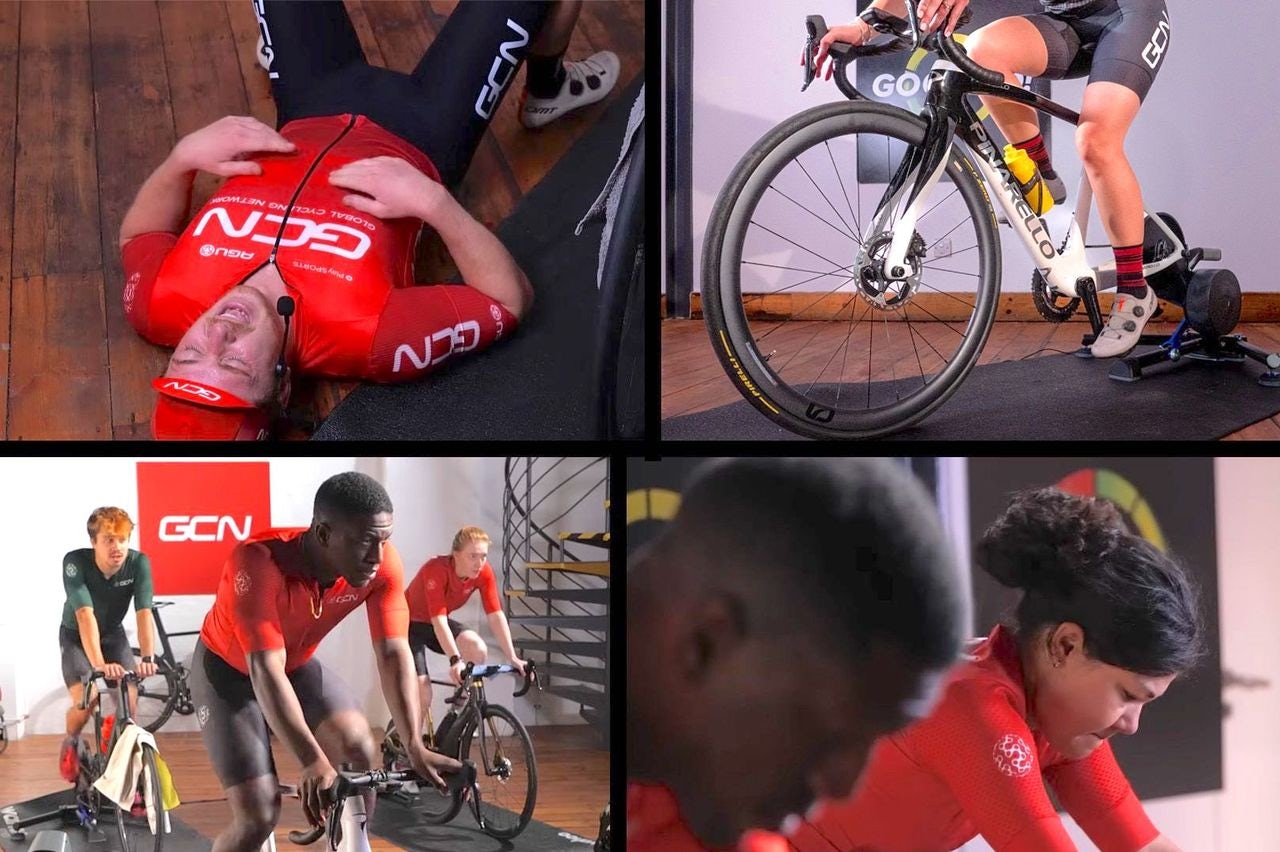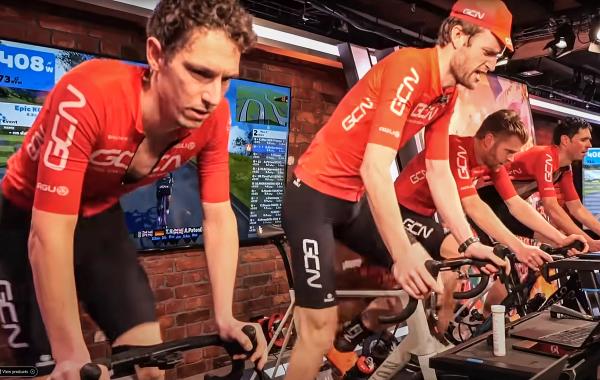GCN's best indoor cycling workouts: FTP, VO2, HIIT & Endurance
Our favourite training sessions, guides and tips for building a training plan
Tom Hallam-Gravells
Online Production Editor
© GCN
Our best indoor training workouts, all in one place
With the help of a turbo trainer, you can take your riding indoors on those wet and gloomy days when, let’s be honest, riding outdoors just isn’t much fun.
Far from just a way of avoiding the weather, turbo trainers or indoor bikes are often the most efficient way of training. With no traffic to contend with, junctions to cross, or the constant stop-and-starting that naturally comes with roads, you can pack in a more flowing and uninterrupted workout.
Of course, it’s not just a matter of hopping on the turbo trainer and pedalling away. To maximise your fitness gains and improve your FTP, you’ll need to follow structured workouts that target specific training zones, whether that be through a HIIT effort that raises your VO2 max, a gentler spin to aid recovery, or a flat-out sprint to build muscle and burn fat.
Whatever you want to achieve through turbo training, GCN has you covered. We’ve got a wide selection of indoor workouts for every type of need and you can explore our top picks below. All of our workouts are based on perceived effort, from 1/10 all the way through to 10/10.
For many more workouts, head over to the training section of the GCN website, linked here.
Contents
Jump to:
- Do I need a training plan?
- How to create a training plan
- GCN’s favourite indoor workouts for improving VO2 max
- Best GCN indoor sweet spot workouts
- GCN’s HIIT indoor cycling workouts
- GCN’s sprint cycling workouts to improve anaerobic fitness
- Improve FTP with GCN’s over-under threshold workouts
- Improve pedalling efficiency with GCN’s cadence workouts
- Best turbo training workouts to improve leg strength
- GCN’s best indoor cycling workouts for beginners
- GCN’s quick indoor cycling workouts: Best workouts under 30-minutes
Do I need a training plan?
While you can just pick random workouts whenever you fancy a ride, your training will be much more effective and efficient if you follow a plan.
A well-crafted plan will be specifically designed to improve certain aspects of performance, for example, high-end power or endurance. Some can have a more rounded approach too, although these generally aren’t quite as effective as something more targeted.
How to create a training plan
See our full guide on making a training plan here.
Understand cycling training zones
Training zones separate the different levels of intensity at which we ride. There are a few different frameworks that people use, but no matter how you divide your effort levels up, training zones allow you to consistently ride at certain intensities, all with different benefits.
Each of the different training zones is calculated as a percentage using either your FTP (functional threshold power) or maximum heart rate. So, a training zone may be 80-85% of your maximum heart rate or FTP.
Have clear goals before starting
Training is more efficient when there is a clear goal, plus it’s much easier to motivate yourself for a ride if you have a target in mind.
Once you’ve set a goal, think about how you need to improve to reach it. This will make it easier to create your training plan and to ensure that you incorporate workouts that will benefit your needs.
- Read more: How to do an FTP test
Mix things up: Cycling and strength workouts
While cycling workouts should make up most of the plan, it’s also good to mix things up with other types of training too. Strength training, although dreaded by many cyclists, has multiple benefits and is definitely one to include. It can help to prevent injuries and improve posture on the bike.
Plan ahead
Life often gets in the way of riding and that can sometimes be unavoidable. However, try to plan workouts around your other commitments. That way, you can try to avoid the risk of any clashes. If they start stacking up, it’s easy to lose momentum and for a training plan to come to a grinding halt.
- Read more: How to make your own training plan
GCN’s favourite indoor workouts for improving VO2 max
There are two ways for cyclists to generate their power, either aerobically or anaerobically. Aerobic efforts are powered using oxygen whereas anaerobic exercise goes beyond the threshold where the body can supply enough oxygen, like an all-out sprint.
Naturally anaerobic efforts aren’t sustainable for long periods of time so riders rely most heavily on aerobic efforts, which is where VO2 max comes into the equation as one of the most important training zones.
Why is VO2 max important to cyclists?
VO2 max is the maximum amount of oxygen your body can absorb at one time. As soon as you go above your VO2 max, you enter the anaerobic zone which, as discussed, isn’t sustainable for very long. Efforts under VO2 max are sustainable for longer periods, but the amount of power you can hold for these efforts will depend on how high your VO2 max is. The higher it is, the more oxygen your body can process and the more power you can sustain.
It has a huge bearing on a rider’s ability which is why it’s one of the biggest markers for performance, especially for pro cyclists, but also for amateur riders too.
How to improve VO2 max through indoor cycling workouts
Research has shown that high-intensity intervals are one of the best ways to improve VO2 max. These usually consist of over-under intervals like in the workout below, where the effort level rotates between a level below your VO2 max and then above. Targeting levels above your VO2 max helps your body to adapt to the increased demand.
Hank’s VO2 max booster: 30-minute over-under interval training
Follow along with the session here.
- Warm up for nine minutes. Start with two minutes at 2/10, then 3/10, followed by 4/10. End the warm up with one minute at 6/10, then another at 8/10, before bringing it down to 3/10
- Complete three sets of five-minute over-under intervals. Each consists of two minutes at 7/10 followed by one minute at 9/10, before returning to 7/10 for the final two minutes
- Recover for two minutes between each set at 3/10. If you need extra time, add another two minutes to this recovery period
- Warm down for two minutes at 3/10. Extend this warm down if you have more time to flush out the lactic acid
More VO2 max workouts from GCN:
- Hank’s intense 30-minute VO2 max workout
- Have limited time? Here’s a short VO2 max indoor workout
- These VO2 max efforts will leave your legs and lungs burning
Best GCN indoor sweet spot workouts
Traditionally, to build endurance, it was believed that cyclists had to slog it out through the winter on long, slow and gruelling training rides, commonly referred to as base miles. While these can be effective, you don’t necessarily need to log lots of hours to build up your endurance. Instead, the same improvements can be made through indoor cycling.
Benefits of regular sweet spot training
One of the most popular ways to do this is through sweet spot training. Sweet spot is a training zone between 85-95% of your FTP. It’s an effort level that you should be able to sustain for over an hour, but it isn’t easy. At the same time, riding at that intensity doesn’t cause too much damage to the muscles, which is why it’s become popular to train in the sweet spot zone among those hoping to improve their endurance.
Below is one example of a sweet spot workout which, at only 30-minutes long, is perfect for time-strapped cyclists, although you can easily extend it if you have more time.
30-minute sweet spot training: Manon’s half-hour HIIT workout
Follow along with the session here.
- Warm up for six minutes. Make sure you don’t exceed a 4/10 perceived effort and bring it back down to 3/10 for the final minute
- The main workout rotates between a 7/10 and then 5/10 effort, with some sprints squeezed in at the end
- Ride at a 7/10 effort for one minute, then 5/10 for one minute. Replicate these efforts for two minutes and then three minutes, before finishing with two minutes
- Once the final two minutes at 5/10 are complete, it’s time to finish with some sprints
- Bring up your cadence to 100rpm and ride at 8/10 for one minute, followed by one minute at 2/10. Repeat both of these efforts for 30 seconds
- Finish with a 30-second sprint at 9/10, followed by two minutes at 2/10.
- Cool down for four minutes, starting at 4/10 and slowly working down to 3/10
More GCN sweet spot workouts
- Improve your FTP with Conor Dunne’s 30-minute sweet spot training
- Sweet spot training is sweaty work so it’s easier with a fan. Here’s why
- Improve your aerobic capacity with Manon’s time trial efforts
GCN’s HIIT indoor cycling workouts
HIIT stands for high-intensity interval training. From pro riders to amateurs alike, HIIT workouts are a staple of training plans as the high intensity is effective at boosting fitness as well as improving general health, especially for those who want to burn some calories.
The intervals in a HIIT workout can be anywhere from 10 seconds long to over five minutes, depending on the intensity you want to ride at, and are partnered with a spell of recovery after each interval. This recovery period will vary depending on the length of the workout.
What are the performance benefits of HIIT training?
HIIT intervals are only short and intense as you’ll usually be riding around the upper threshold or above your VO2 max. However, this intensity leads to strong fitness gains, although the specific performance improvements will depend on the length of the intervals.
Shorter ones, usually around 10 seconds, will boost your high-end power, while longer intervals can improve sustained power and ability to shuttle lactate out of the muscles.
Building anaerobic performance without cycling every day
Manon’s HIIT workout below will test your top-end power, which means you’ll be working anaerobically - this is when exercise exceeds your level of oxygen consumption. It’s seriously tough and forces your body to produce energy by breaking down your muscles. It’ll take time for your body to recover after you’ve finished exercising but that’s good as your muscles build strength through this process. To learn more about anaerobic exercise and how it differs from aerobic exercise, check out this study.
Manon’s favourite HIIT pyramid workout
Follow along with the session here.
- HIIT are intense so a thorough warm up is required. Warm up for 11 minutes, spending two minutes at 2/10, 3/10, 4/10 and 6/10, followed by one minute at 8/10. Finish with two minutes at 3/10 to allow your body to recover before the main intervals.
- The main interval is a pyramid which works up to a high effort level and then back down again. Work your way from a 1/10 effort level through to 10/10, spending one minute at each effort level. There are no rests in between.
- Once you’ve finished the 10/10 effort, work your way back down the pyramid, starting from 9/10 and finishing at 1/10. This should once again be one minute at each effort level.
- End with a cool down. The longer you warm down for, the better your legs will feel the day after.
HIIT indoor workouts to burn calories and lose weight
If weight loss is your goal, cycling is a great way to burn calories. Doing this means running a calorie deficit, whereby you burn more calories than you consume, but it’s important to be careful when you’re training. Avoid cutting calories before or straight after rides as this will hamper your fuelling and recovery. Then think about calorie reductions at other times that won’t impact your cycling.
Does HIIT training burn fat and calories?
As it’s a seriously hard level to ride at, HIIT training will burn lots of calories and, in a win-win situation, will also improve your fitness and boost your FTP. If you want to burn fat, HIIT training is a good place to start.
Research suggests that HIIT burns more calories than easier, steady state riding and. As an added bonus, if you are training consistently, HIIT will increase your basal metabolic rate. This means that your body will become even more efficient at burning calories.
Manon’s short HIIT workout for burning calories fast
Follow along with the session here.
- Warm up for four minutes. Ride at at 2/10 for one minute, then 4/10 for a minute, finishing with 3/10 for two minutes.
- Complete the first set of intervals, completing two one-and-a-half minute intervals at 8/10 with 30 seconds at 5/10 in between. Spin the legs for two minutes at 2/10 when complete.
- Start the second set of intervals with one minute at 9/10, followed by 30 seconds at 5/10, before finishing with one minute at 8/10.
- Take two minutes recovery at 2/10.
- For the final set, complete two two-minute intervals at 8/10 with 30 seconds at 5/10 in between.
- Finish the session with a one-and-a-half minute cool down at 2/10. This warm down is only short so, for maximum benefits and recovery, extend it if you have more time.
More HIIT training workouts from GCN
- 30-minute HIIT workout for fast fitness gains
- HIIT workout with tough sprints that will leave your legs burning
- GCN’s sharp and punchy HIIT workout for maximum fitness gains
- Manon Lloyd’s HIIT for those who want to improve their acceleration
- A workout to make a former pro cyclist’s legs tremble - Conor Dunne’s hardest HIIT hit out
- Team time trial HIIT workout for those who want to replicate race efforts
GCN’s sprint cycling workouts to improve anaerobic fitness
Sprinting may leave your legs and lungs burning, but a strong sprint is key to cycling success in virtually every type of riding. It doesn’t matter if you’re a road cyclist or a mountain biker, you’re going to need a strong sprint.
Unfortunately for those with an aversion to sprinting, the only way to build high-end power is through regular sprint/anaerobic training.
What are the benefits of regular sprint training?
Anaerobic exercise, like in the workout provided by Manon below, exceeds the body’s ability to process oxygen. At these levels, the body has to recruit its energy by other means, like breaking down muscles. This causes short-term damage to the muscles but long-term gain as when they become stronger through the recovery process, leading to a welcome boost to your high-end power.
For those wanting to lose weight, a study in the National Library of Medicine found that sprint training burns more calories in a shorter period of time than steady-state exercise too.
Manon’s 20-minute indoor cycling workout with sprints
Follow along with the workout here
- Sprint workouts are tough and require a thorough warm up. Start at 2/10 for two minutes and then spend 30 seconds at 4/10 and 6/10. Finish by loosening the legs with one minute at 2/10 before the main interval.
- The session consists of four sprint efforts. For the first three efforts, spend one minute at 7/10, then 30 seconds at 9/10, followed by one minute at 3/10.
- The final effort ramps up from 5/10 for one minute, to two minutes at 7/10, before reaching 30 seconds at 9/10. End with two minutes at 7/10.
- Warm down for four and a half minutes, starting easy at 3/10, then moving up to 7/10, before ending with 2/10.
More sprint spin workouts from GCN
- Five-minute efforts with sprints to boost your maximum power
- Mix things up with tempo efforts and sprints
- Tempo efforts with sprints for those who want to sharpen their sprint
- Maximum sprints for those who want an all-out workout
- Conor’s ‘sprintervals’ to add more punch to your sprint
Improve FTP with GCN’s over-under threshold workouts
A rider’s threshold is the maximum power they can sustain for a prolonged period of time, usually around an hour. It’s regularly referred to as FTP (functional threshold power) and is the benchmark most cyclists use to measure their fitness.
The threshold training zone sits at around 95-100% of a rider’s FTP and it’s in this range that you usually also find a rider’s lactate threshold, which is the point at which the muscles start taking on lactate faster than they can clear it. Targeting the threshold training zone will increase a rider’s FTP and lactate threshold.
Benefits of over/under threshold intervals
The best way to target the threshold training zone is through over/under intervals, like in the workout below. This contains alternating 90-intervals at 7/10 and then 9/10. It will build up lactate as you ride which will improve your body’s ability to remove lactate in the future.
Training at this intensity also improves aerobic capacity, which is where the boost to your FTP comes in.
GCN’s 35-minute over/under threshold workout
Follow along with the workout here.
- Warm up for six minutes. Start with one minute at 3/10, then two minutes at 4/10, another one minute at 6/10 and then finally two minutes at 4/10.
- There are eight sets of three-minute intervals. Each starts with 90 seconds at 9/10 and finishes with 90 seconds at 7/10.
- After the first four sets, it’s time for a little recovery with two minutes at 3/10, before continuing with the final four sets.
- Your legs should be filled with lactate and will need a thorough warm down. As a minimum, complete three minutes at 3/10.
More over/under workouts and advice from GCN
- Conor’s over-under HIIT workout to boost your FTP
- You can keep track of how your interval training is going through regular FTP tests. Here’s how
Improve pedalling efficiency with GCN’s cadence workouts
Cadence is a measure of how quickly the cranks on a bike are rotating, measured in RPM (revolutions per minute). It’s an important but often overlooked factor as it has a big impact on performance and efficiency.
Many cyclists ride at a low cadence but that places extra strain on the muscles. So, what is a good cadence? There isn’t a hard-and-fast rule for this but, generally, it should be above 80rpm, although many cyclists go above 90rpm.
On the flip side, there will be occasions when you have no choice other than to ride at a low cadence, like those wall-like climbs that inspire dread and inflict plenty of suffering to go alongside it. For these, grinding is the only option, so you ideally need to be comfortable at different cadences.
How to improve cadence efficiency from indoor workouts
Cadence efficiency can easily be improved through workouts like the one below. It targets a range of different cadences and, when practised over time, will expand your cadence range and improve your pedalling efficiency. It does this by moving between different RPMs. By targeting more extreme cadences, both lower at 60rpm and higher at 110rpm, muscles begin to adapt to the unique demands. This will lead to better control when riding at a more regular cadence.
The key is regular practice as you’ll get better the more you complete workouts. Also try to consciously focus on pedalling efficiency, making sure your legs pump up and down like pistons.
GCN’s indoor cadence drills workout
Follow along with this session here.
- Warm up for six minutes, starting with one minute at 2/10, then two minutes at 3/10, followed by one minute at 5/10 and, finally, two minutes at 3/10.
- The session consists of four-minute blocks at 7/10. Starting at 60rpm, rotate between 110rpm every minute.
- Return your cadence to a comfortable level for two minutes at 2/10 between each block.
- Finish with a short burst of one minute at 8/10 at 100rpm.
- Make sure you thoroughly warm down to work any lactate out of the muscles. We’ve only included one minute in this workout but aim for longer.
More cadence drills indoor workouts
- Conor Dunne’s high cadence workout
- Low cadence climbing workout
- Fast-paced cadence drills
- Need a quick and easy cadence workout? Here’s GCN’s top pick
Best turbo training workouts to improve leg strength
Cyclists aren’t exactly known for their strength. Instead, many live up to the weedy stereotype, as is often displayed by the GCN presenters as soon as we task them with any core training.
Despite this, strength training does matter and it’s not just about building up core strength through off-the-bike exercise. It’s also important to build leg strength through on-the-bike workouts too, which will come in handy on those occasions when you’re forced to ride at a lower cadence, usually on vicious gradients.
How indoor cycling workouts can build leg strength and improve climbing performance
Naturally, riding at higher power zones will build strength but there is a limit to this. Lower cadences drills are a good way to add more of a strength workout into training, as this takes more of the strain away from the cardio system and dumps it on the legs. It’ll leave your legs burning by the end, but that’s the point, right?
A session like below, which takes things all the way down to 60rpm, can also help to expand your comfortable range of cadence, improving efficiency, while also aiding climbing performance - particularly for those gruelling climbs with double-digit gradients.
Build leg strength with Conor’s 30-minute workout
Follow along with the session here.
- As this session is only short, we’ll only complete a three-minute warm-up. Spend two minutes at 2/10 followed by one minute at 4/10, both in a comfortable cadence.
- This session alternates between riding at 60rpm and 100rpm.
- Spend the first 30 seconds at 100rpm at 6/10, then carry on that pedal speed for one minute at 7/10. Recover with two minutes at 3/10, at 80rpm.
- Thinks crank up a level next with two minutes at 7/10 and one minute at 8/10, both at 60rpm. This will be slow, but persevere and try to get into a rhythm. Take one-minute recovery at 2/10 at 90rpm.
- Repeat the last set two more times.
- After the last set, swap the recovery period for one minute at 8/10 at 90rpm, just to give a little shock to the system and disrupt your rhythm.
- Your legs will feel heavy after a leg-strength exercise like this, so spin the legs for at least 90 seconds at an easy effort level. You body will recover better if you extend the warm down for longer.
More leg-strength workouts from GCN
- Want some off-the-bike strength exercises? Here’s GCN’s pick of the best body-weight exercises
- Learn how to incorporate off-the-bike strength training into a training plan
- Want to avoid the gym? Here are other ways to boost your leg strength
GCN’s best indoor cycling workouts for beginners
If you’re new to cycling, start things off slowly. Your body will need time to adapt to training, especially if you’re completing some high-intensity workouts.
Sweet spot is a good place to start. It’s a relatively hard level of cycling that will leave you slightly out of breath but doesn’t put too much strain on the muscles, so your legs shouldn’t be sore for days afterwards.
How to structure an indoor workout for beginners
Always start any workout with a warm up. This will give your muscles and cardio system time to fire up before any of the more intense efforts start.
Replicate this at the end of the workout too with a warm down, which will flush out any lactic acid and bring your heart rate down.
The middle of the workout will vary depending on the type and goal, but listen to your body and if you’re overly struggling, take things down a notch. Many cyclists base their workouts around their FTP but this may not be effective for new cyclists who aren’t used to doing harder efforts, in which case you may end up over training.
We’ve pulled together a great beginner workout below, which combines 7/10 and 8/10 efforts, but only for shorter periods of time. It’s a great introduction to workouts and, as you get fitter and more used to training, these efforts will become longer, plus you’ll be able to push out more power at a certain perceived effort level.
20-minute indoor training session for beginners
Follow along with the session here.
- Always warm up prior to a workout. For this session, we have a six-minute warm up, spending two minutes at 2/10, 3/10 and then 4/10.
- For the main session, ramp up from 5/10 to 6/10 and then 7/10, spending two minutes at each level.
- Ride at 3/10 for two minutes. Always maximise these spells of recovery, taking time to capture your breath. This will help when the effort ramps back up.
- Finish with two minutes at 8/10.
- A cool down is also essential after a workout and will aid the recovery process. For this workout, we recommended a four-minute warm down, split between two minutes at both 5/10 and 3/10. If you have time, extend this.
More beginner indoor workouts from GCN
- Easy zone 2 workout to improve endurance, perfect for beginners
- New to indoor cycling? Here are the best ways to build endurance with a turbo trainer
- Hank’s easy 25-minute indoor training session for beginners and recovery
- Starting indoor training can be daunting. Here’s how to successfully navigate those first workouts
GCN’s quick indoor cycling workouts: Best workouts under 30-minutes
In an ideal world, we’d be free to ride our bikes whenever we wanted. Life isn’t that simple, though. Jobs, family, friends and events all get in the way, leaving little scope for time in the saddle.
30-minute workouts: Are they effective?
Turbo trainers can be really handy for time-strapped cyclists, as you can jump on whenever you have a small gap in your schedule. And, even if you only have 30 minutes, you can still pack in a good workout - any riding is better than none!
Sure, it may not build your fitness as much as a longer workout, but frequent short and focussed training sessions are a great way to build fitness, like Manon’s example below.
A great example, this 30-minute workout packs in plenty of bang for its buck. The multiple sprint efforts will leave your legs and lungs burning, building muscular endurance and anaerobic capacity.
Manon’s favourite workout for time-strapped cyclists
Follow along with the session here.
- Warm up for six minutes. Start with one minute at 2/10, then two minutes at 3/10, before ending with one minute at 6/10. Spin the legs for a further two minutes at 3/10 before starting the main interval.
- Each set of intervals is three minutes long.
- For the first, take things up to 8/10 for 90 seconds before bringing the level back down to 5/10 for 90 seconds. Take two minutes at 3/10 to recover.
- Reverse the order for the second interval, starting with 5/10 followed by 8/10. Bring the recovery time down afterwards to 90 seconds at 3/10.
- For the third interval, start with 8/10 followed by 5/10 and, once again, take 30 seconds off the recovery time so it is only one minute.
- Things crank up a level for the next interval to 9/10 followed by 6/10. Complete this twice with 30 seconds at 3/10 between the two sets.
- Always warm down and make sure you eat correctly to help your body recover. The warm down should be at least four minutes of easy spinning.
More workouts for time-strapped cyclists
- Short but sharp 20-minute workout for those short on time
- All of our favourite workouts for time-strapped cyclists, all in one place
- Here’s how to build endurance without having to sacrifice lots of time
- GCN’s quick but brutal 15-minute indoor cycling workout for those who want a fast hit out

.jpg?rect=957,780,3097,3060&w=600&auto=format)










.jpg?w=600&auto=format)



